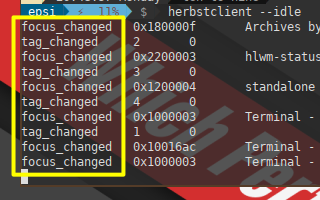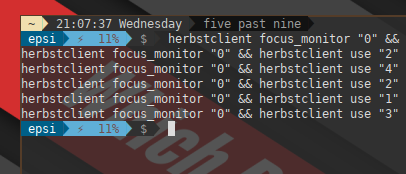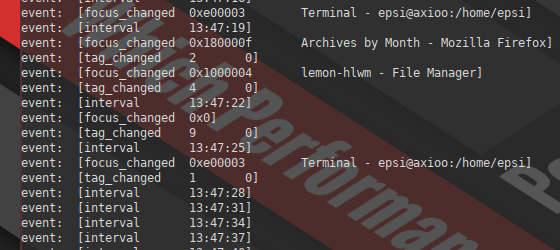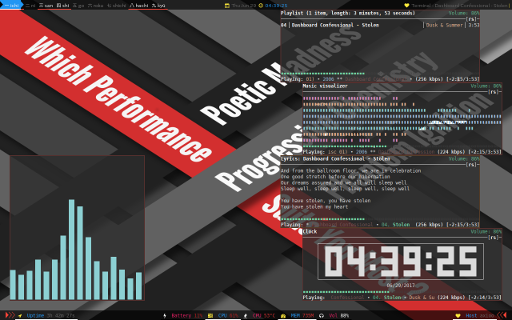Preface
Goal: Manage Herbstclient process trigerred by idle event
Focusing in "herbstclient --idle".

This is the next Part, of the previous Tutorial. This tutorial cover Lemonbar. In order to use Dzen2, any reader could use the source code in github.
Table of Content
Reference
Reading
Before you jump off to scripting, you might desire to read this overview.
All The Source Code:
Impatient coder like me, like to open many tab on browser.
-
Lemonbar: gitlab.com/…/dotfiles/…/haskell/
The PipeHandler Source File:
Let’s have a look at pipehandler.hs in github.
Statusbar Screenshot
Dzen2

Lemonbar

1: Without Idle event
Let’s have a look at our main
panel.hs in github.
At the end of the script, we finally call lemonbar
with detachLemon function.
main = do
...
-- remove all lemonbar instance
system "pkill lemonbar"
-- run process in the background
detachLemon monitor lemonParametersView Source File:
Run Lemon, Run !
This detachLemon function.
is just a function that enable
the lemonbar running process to be detached,
using forkProcess().
detachLemon :: Int -> [String] -> IO ProcessID
detachLemon monitor parameters = forkProcess
$ runLemon monitor parametersThe real function is runLemon.
You must be familiar with this createProcess.
runLemon :: Int -> [String] -> IO ()
runLemon monitor parameters = do
let command_out = "lemonbar"
(Just pipe_lemon_in, _, _, ph) <-
createProcess (proc command_out (parameters ++ ["-p"]))
{ std_in = CreatePipe }
contentInit monitor pipe_lemon_in
hClose pipe_lemon_inNote: that we want to ignore idle event for a while.
And append the -p for a while,
to make the statusbar persistent.
Statusbar Initialization
Here we have the contentInit.
It is just an initialization of global variable.
We are going to have some loop later in different function,
to do the real works.
contentInit :: Int -> Handle -> IO ()
contentInit monitor pipe_lemon_in = do
setTagValue monitor
setWindowtitle ""
text <- getStatusbarText monitor
hPutStrLn pipe_lemon_in text
hFlush pipe_lemon_inNow is time to try the panel, on your terminal.
Note: that we already reach this stage in our previous article.
These two functions, setTagValue
and setWindowtitle, have already been discussed.
View Source File:
Simple version. No idle event. Only statusbar initialization.
2: With Idle event
Consider this contentWalk call,
after contentInit call,
inside the runLemon.
runLemon :: Int -> [String] -> IO ()
runLemon monitor parameters = do
let command_out = "lemonbar"
(Just pipe_lemon_in, _, _, ph) <-
createProcess (proc command_out parameters)
{ std_in = CreatePipe }
contentInit monitor pipe_lemon_in
contentWalk monitor pipe_lemon_in -- loop for each event
hClose pipe_lemon_inWrapping Idle Event into Code
contentWalk is the heart of this script.
We have to capture every event,
and process the event in event handler.
Walk step by step, Process event by event
After the event handler,
we will get the statusbar text, in the same way,
we did in content_init.
contentWalk :: Int -> Handle -> IO ()
contentWalk monitor pipe_lemon_in = do
let command_in = "herbstclient"
(_, Just pipe_idle_out, _, ph) <-
createProcess (proc command_in ["--idle"])
{ std_out = CreatePipe }
forever $ do
-- wait for next event
event <- hGetLine pipe_idle_out
handleCommandEvent monitor event
text <- getStatusbarText monitor
hPutStrLn pipe_lemon_in text
hFlush pipe_lemon_in
hClose pipe_idle_out3: The Event Handler
For each idle event, there are multicolumn string. The first string define the event origin.

The origin is either reload, or quit_panel,
tag_changed, or tag_flags,
or tag_added, or tag_removed,
or focus_changed, or window_title_changed.
More complete event, can be read in herbstclient manual.
All we need is to pay attention to this two function.
set_tag_value and set_windowtitle.
getColumnTitle :: [String] -> String
getColumnTitle column
| length(column) > 2 = column !! 2
| otherwise = ""
handleCommandEvent :: Int -> String -> IO ()
handleCommandEvent monitor event
| origin == "reload" = do system("pkill lemonbar"); return ()
| origin == "quit_panel" = do exitSuccess; return ()
| elem origin tagCmds = do setTagValue monitor
| elem origin titleCmds = do setWindowtitle $ getColumnTitle column
where
tagCmds = ["tag_changed", "tag_flags", "tag_added", "tag_removed"]
titleCmds = ["window_title_changed", "focus_changed"]
-- find out event origin
column = splitOn "\t" event
origin = column !! 0Actually that’s all we need to have a functional lemonbar. This is the minimum version.
View Source File:
With idle event. The heart of the script.
4: Lemonbar Clickable Areas
This is specific issue for lemonbar, that we don’t have in dzen2.
Consider have a look at
output.hs.
-- clickable tags
textName = "%{A:herbstclient focus_monitor \""
++ show(monitor) ++ "\" && " ++ "herbstclient use \""
++ tagIndex ++ "\":} " ++ tagName ++ " %{A} "Issue: Lemonbar put the output on terminal instead of executing the command.

Consider going back to
pipehandler.hs.
We need to pipe the lemonbar output to shell.
It means Lemonbar read input and write output at the same time.
createProcess does good with bidirectional pipe.
runLemon :: Int -> [String] -> IO ()
runLemon monitor parameters = do
let command_out = "lemonbar"
(Just pipe_lemon_in, Just pipe_lemon_out, _, ph) <-
createProcess (proc command_out parameters)
{ std_in = CreatePipe, std_out = CreatePipe }
(_, _, _, ph) <-
createProcess (proc "sh" [])
{ std_in = UseHandle pipe_lemon_out }
contentInit monitor pipe_lemon_in
contentWalk monitor pipe_lemon_in -- loop for each event
hClose pipe_lemon_in
hClose pipe_lemon_outHow does it work ?
UseHandle take care of this.
{ std_in = UseHandle pipe_out }View Source File:
Piping lemonbar output to shell, implementing lemonbar clickable area.
5: Interval Based Event
We can put custom event other than idle event in statusbar panel. This event, such as date event, called based on time interval in second.
It is a little bit tricky, because we have to make, a combined event that consist of, idle event (asynchronous) and interval event (synchronous). Merging two different paralel process into one.
This is an overview of what we want to achieve.

In real code later, we do not need the timestamp.
interval string is enough to trigger interval event.
View Testbed Source File:
Before merging combined event into main code, consider this test in an isolated fashion.
6: Combined Event
Preparing The View
This is what it looks like, an overview of what we want to achieve.

Consider make a progress in
output.hs.
module MyOutput ( ..., setDatetime, ...) where
segmentDatetime :: IORef String
segmentDatetime = unsafePerformIO $ newIORef "" -- empty string
wFormatTime :: FormatTime t => t -> String -> String
wFormatTime myUtcTime myTimeFormat = formatTime
Data.Time.Format.defaultTimeLocale myTimeFormat myUtcTime
getStatusbarText :: Int -> IO String
getStatusbarText monitor = do
tags <- readIORef tagsStatus
let tagText = "%{l}" ++ (join $ map (outputByTag monitor) tags)
timeText <- ("%{c}" ++) <$> outputByDatetime
titleText <- ("%{r}" ++) <$> outputByTitle
let text = tagText ++ timeText ++ titleText
return text
outputByDatetime :: IO String
outputByDatetime = do
segment <- readIORef segmentDatetime
return segment
formatDatetime :: ZonedTime -> String
formatDatetime now = dateText ++ " " ++ timeText
where
...
setDatetime :: IO ()
setDatetime = do
now <- getZonedTime
writeIORef segmentDatetime $ formatDatetime nowAnd a few enhancement in
MyPipeHandler.hs.
wSleep :: Int -> IO ()
wSleep mySecond = threadDelay (1000000 * mySecond)
handleCommandEvent :: Int -> String -> IO ()
handleCommandEvent monitor event
...
| origin == "interval" = do setDatetime
where
...
contentInit :: Int -> Handle -> IO ()
contentInit monitor pipe_lemon_in = do
...
setWindowtitle ""
setDatetime
...Expanding The Event Controller
All we need to do is to split out content_walk into
-
content_walk: combined event, with the help ofcatprocess. -
content_event_idle: HerbstluftWM idle event. Forked, as background processing. -
content_event_interval: Custom date time event. Forked, as background processing.
contentEventIdle :: Handle -> IO ()
contentEventIdle pipe_cat_in = do
let command_in = "herbstclient"
(_, Just pipe_idle_out, _, ph) <-
createProcess (proc command_in ["--idle"])
{ std_out = CreatePipe }
forever $ do
-- wait for next event
event <- hGetLine pipe_idle_out
hPutStrLn pipe_cat_in event
hFlush pipe_cat_in
hClose pipe_idle_outcontentEventInterval :: Handle -> IO ()
contentEventInterval pipe_cat_in = forever $ do
hPutStrLn pipe_cat_in "interval"
hFlush pipe_cat_in
wSleep 1contentWalk :: Int -> Handle -> IO ()
contentWalk monitor pipe_lemon_in = do
(Just pipe_cat_in, Just pipe_cat_out, _, ph) <-
createProcess (proc "cat" [])
{ std_in = CreatePipe, std_out = CreatePipe }
forkProcess $ contentEventIdle(pipe_cat_in)
forkProcess $ contentEventInterval(pipe_cat_in)
forever $ do
-- wait for next event
event <- hGetLine pipe_cat_out
handleCommandEvent monitor event
text <- getStatusbarText monitor
hPutStrLn pipe_lemon_in text
hFlush pipe_lemon_in
hClose pipe_cat_out
hClose pipe_cat_inThis above is the most complex part. We are almost done.
View Source File:
Combined event consist of both, synchronous interval event and asynchronous idle event.
7: Dual Bar
The idea of this article comes from the fact
that herbsclient --idle is asynchronous event.
If you need another bar, just simply use Conky instead.
-
Dzen2:

-
Lemonbar:

We only need one function to do this in
pipehandler.pm.
detachLemonConky :: [String] -> IO ()
detachLemonConky parameters = do
-- Source directory is irrelevant in Haskell
-- but we'll do it anyway for the sake of learning
dirName <- getCurrentDirectory
let conkyFileName = dirName ++ "/../conky" ++ "/conky.lua"
(_, Just pipeout, _, _) <-
createProcess (proc "conky" ["-c", conkyFileName])
{ std_out = CreatePipe }
(_, _, _, ph) <-
createProcess (proc "lemonbar" parameters)
{ std_in = UseHandle pipeout }
hClose pipeoutAnd execute the function main script in
panel.pl.
-- This is a modularized config for herbstluftwm tags in lemonbar
import System.Environment
import System.Process
import MyHelper
import MyPipeHandler
-- initialize
panelHeight = 24
-- ----- ----- ----- ----- ----- ----- ----- ----- ----- ----- -----
-- main
main = do
args <- getArgs
let monitor = getMonitor args
geometry <- getGeometry monitor
system "pkill lemonbar"
system $ "herbstclient pad " ++ show(monitor) ++ " "
++ show(panelHeight) ++ " 0 " ++ show(panelHeight) ++ " 0"
-- run process in the background
let paramsTop = getParamsTop panelHeight geometry
detachLemon monitor paramsTop
let paramsBottom = getParamsBottom panelHeight geometry
detachLemonConky paramsBottom
-- end of IO
return ()View Source File:
Dual Bar, detach_lemon_conky function.
8: Avoid Zombie Apocalypse
Zombie are scary, and fork does have a tendecy to become a zombie. Application that utilize several forks should be aware of this threat. The reason why I use fork instead of thread is, because the original herbstluftwm configuration coming from bash, and this bash script is using fork.
However, you can use this short script to reduce zombie population.
It won’t kill all zombie, but works for most case.
You might still need htop,
and kill -9 manually.
killZombie :: IO ()
killZombie = do
system "pkill -x dzen2"
system "pkill -x lemonbar"
system "pkill -x cat"
system "pkill conky"
system "pkill herbstclient"
return ()9: Putting Them All Together
I also created compact for version,
for use with main HerbstluftWM configuration,
in ~/.config/herbstluftwm/ directory.
After reunification, they are not very long scripts after all.
Desktop Screenshot
Fullscreen, Dual Panel, Zero Gap.
Enjoy the statusbar ! Enjoy the window manager !
